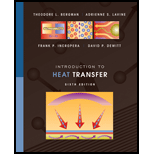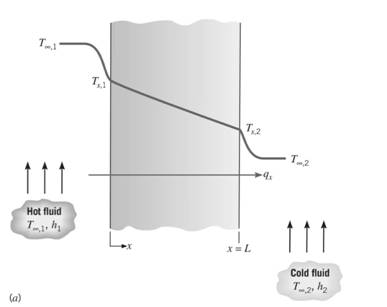
Consider the plane wall of Figure 3.1, separating hot andcold fluids at temperatures
The temperature distribution within the wall and the heat flux.
Answer to Problem 3.1P
The temperature distribution:
The heat flux:
Explanation of Solution
Given information:
Temperature of hot fluid is
Temperature of cold fluid is
Figure of the plane wall:

Calculations:

From the general solution of the heat diffusion equation:
Substituting in equation (1), the temperature distribution is:
Now find the heat flux using the fourier’s law:
Conclusion: The temperature distribution within the wall is
Want to see more full solutions like this?
Chapter 3 Solutions
Introduction to Heat Transfer
- A long steel rod 0.305 m in diameter is initially at a temperature of 588 K. It is immersed in an oil bath maintained at 311 K. The surface convective coefficient is 125 W/m2 -K. Calculate the temperature at the center of the rod after 1 h. The average physical properties of the steel are k = 38 W/m-K and α = 0.0381 m2/h.arrow_forwardIn infinitely long parallel plates, Biot number and Fourier number are 0.2 and (10).Find the temperature distribution at center, temperature distribution at plate surface, andactual to maximum heat transfer ratio. uses charts/table also if neededarrow_forwardThe boiling temperature of nitrogen at atmospheric pressure at sea level (1 atm) is -196°C. Therefore, nitrogen is commonly used in low temperature scientific studies since the temperature of liquid nitrogen in a tank open to the atmosphere will remain constant at -196°C until the liquid nitrogen in the tank is depleted. Any heat transfer to the tank will result in the evaporation of some liquid nitrogen, which has a heat of vaporization of 198 kJ/kg and a density of 810 kg/m3 at 1 atm. Consider a 3-m-diameter spherical tank initially filled with liquid nitrogen at 1 atm and 196°C. The tank is exposed to 22°C ambient air with a heat transfer coefficient of 22 W/m2 · °C. The temperature of the thin-shelled spherical tank is observed to be almost the same as the temperature of the nitrogen inside. Disregarding any radiation heat exchange, determine the rate of evaporation of the liquid nitrogen in the tank as a result of the heat transfer from the ambient air in kg/sec. Answer in…arrow_forward
- In infinitely long parallel plates, Biot number and Fourier number are 0.2 and (15).Find the temperature distribution at center, temperature distribution at plate surface, andactual to maximum heat transfer ratio.arrow_forwardcylindrical fuel element for a gas-cooled nuclear reactor, the heat generation rate within the fuel element due to fission can be approximated by the relation: q(r) = q_0 [1 - (r/a)^2] W/m^3 where a is the radius of the fuel element and q_0 is constant. The boundary surface at r = a is maintained at a uniform temperature T_0. Assuming one-dimensional, steady-state heat flow, develop a relation for the temperature drop from the centerline to the surface of the fuel element. For radius a= 30mm, the thermal conductivity k = 10 W/m middot K and q_0 = 2 times 10^7 W/m^3, calculate the temperature drop from the centerline to the surface.arrow_forwardFluid fluid with a temperature of -20C passes through a copper cylindrical wire. The outer diameter of the wire is 10 mm. The wire is in contact with air at a temperature of 25C, which is h = 50 W / m2K. The heat conduction coefficient of the wire is k = 0.5 W / mK. It will be applied in different thicknesses. a) Calculation separately for the resulting heat transfer per m when 0, 2.5, 5 and 7.5 m are applied. b) To interpret which thickness will increase the heat transfer by calculating the critical diameter. c) Graph the insulation and heat transfer rate against each other.arrow_forward
- A thin 100 cm long and 10 cm wide horizontal plate is maintained at a uniform temperature of 150°C in a large tank full of water at 75°C.Estimate the rate of heat to be supplied to the plate to maintain constant plate temperature as heat is dissipated from either side of plate. Don't Chat Gpt and AI .arrow_forwardA 1.2 m long vertical pipe, with a diameter 0.05 m, carrying a mixture of liquid water and vapor at atmospheric pressure is used to heat a very large liquid water tank, with water temperature maintained at 40 C. Calculate how much is the heat rate transferred from the pipe to the surrounding water at steady-state. (Consider the water in the tank at atmospheric pressure.)arrow_forwardA food product with 80% moisture content in a 10 cm diameter can wants to be frozen. The density of the product is 1000 kg / m³, the thermal conductivity is 1.0 W / (m K), and the initial freezing temperature is -2 ° C. After 14 hours in the freezing medium -30 ° C, the product temperature becomes -10 ° C. Estimate the convection heat transfer coefficient of the freezing medium. Assume the can as an infinite cylinder.arrow_forward
- A food product with 80% moisture content in a 5 cm diameter can wants to be frozen. The density of the product is 1000 kg / m cubic, the thermal conductivity is 1.0 W / (m K), and the initial freezing temperature is -1.75 ° C. After 10 hours in -25 ° C freezing medium, the product temperature becomes -10 ° C. Estimate the convection heat transfer coefficient of the freezing medium. Assume the can as an infinite cylinderarrow_forwardA food product with 73% moisture content is being frozen in a 7 cm-diameter can. The product density is 970 kg/m³, the thermal conductivity is 1.2 W/(m K), and the initial freezing temperature is -2.5°C. After 11 hour in the -40°C freezing medium, the product temperature is -10°C. Estimate the convective heat-transfer coefficient for the freezing medium. Assume the can has infinite height. a. h = ... W/m² Karrow_forwardA flat isothermal computer chip has square cross-section of 1 cm x 1 cm, and is mounted on a board that insulates the chip on its sides and bottom. The top surface is exposed to a flowing coolant at 10°C, and corresponding convection coefficient h = 1000 W/m2·K. In order for the computer chip to safely operate, its temperature cannot exceed 65°C. What is the maximum allowable chip power?arrow_forward
 Principles of Heat Transfer (Activate Learning wi...Mechanical EngineeringISBN:9781305387102Author:Kreith, Frank; Manglik, Raj M.Publisher:Cengage Learning
Principles of Heat Transfer (Activate Learning wi...Mechanical EngineeringISBN:9781305387102Author:Kreith, Frank; Manglik, Raj M.Publisher:Cengage Learning
